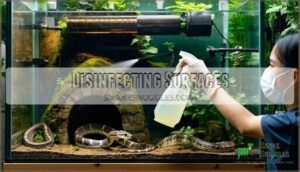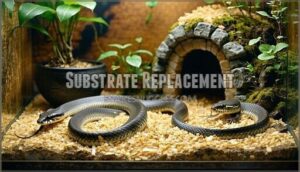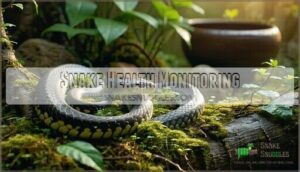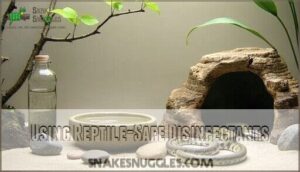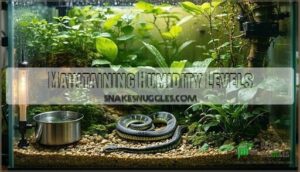This site is supported by our readers. We may earn a commission, at no cost to you, if you purchase through links.
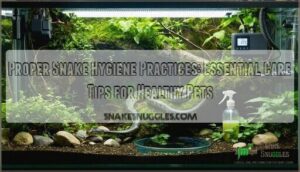
You’ll need to remove waste daily, change substrate monthly, and disinfect surfaces with reptile-safe cleaners.
Keep humidity levels appropriate for your snake’s species to prevent respiratory issues and skin problems.
Monitor your snake’s shedding cycles, breathing patterns, and feeding responses to catch health issues early.
Always wash your hands before and after handling, and use proper gripping techniques to avoid stress.
Regular weight tracking helps identify potential problems before they become serious.
Understanding these fundamentals creates the foundation for more advanced care techniques that can substantially extend your snake’s lifespan.
Table Of Contents
- Key Takeaways
- Snake Handling Hygiene
- Cleaning Snake Enclosures
- Snake Health Monitoring
- Advanced Hygiene Techniques
- Maintaining Humidity Levels
- Frequently Asked Questions (FAQs)
- Are you supposed to give your snake a bath?
- How to clean snake poop and pee?
- How often should you wash your snake?
- How often should water bowls be cleaned?
- Can household cleaners be used on enclosures?
- What gloves are best for snake handling?
- How to sanitize feeding tongs properly?
- When to replace enrichment items completely?
- Conclusion
Key Takeaways
- Clean daily and deep clean monthly – You’ll need to remove waste immediately using tongs, then perform monthly substrate replacement and surface disinfection with reptile-safe cleaners to prevent bacterial growth.
- Handle safely with proper technique – You should support your snake’s mid-body with gentle grips, limit sessions to 10-15 minutes, and watch for defensive postures like S-shaped coiling or hissing that signal you need to back off.
- Monitor health through regular observation – You’ll catch problems early by checking scale conditions weekly, tracking feeding responses, and documenting shedding cycles every 4-8 weeks for signs of illness.
- Maintain proper humidity levels – You need to use a hygrometer for daily monitoring and adjust through misting or water bowls to meet your snake’s species-specific requirements while preventing dangerous mold growth above 70%.
Snake Handling Hygiene
Safe snake handling starts with proper hygiene practices that protect both you and your pet.
You’ll need to master gripping techniques, recognize warning signs, and maintain clean handling sessions to prevent stress and injury, which is crucial for safe handling.
Proper Gripping Methods
Two key principles guide proper snake handling: maintaining Safe Support and reading Body Language.
Safe handling means reading your snake’s signals and supporting them with confidence.
Your snake handling techniques should prioritize gentle, secure grips that distribute weight evenly while using appropriate tools for safety. Understanding defensive snake behavior is also vital for safe interactions.
Essential snake grip fundamentals:
- Mid-body positioning – Place your hands at the snake’s center, avoiding head and tail regions that trigger defensive responses
- Supportive encirclement – Use all fingers to gently wrap around the body, allowing natural movement through your hands without restrictive pressure
- Tool integration – Employ snake hooks for initial contact and thin gloves for larger species, ensuring proper Hook Technique and controlled snake restraint
This approach creates confidence during snake handling safely while respecting Handling Duration limits of 10-15 minutes daily for ideal animal welfare.
Recognizing Defensive Postures
How can you tell when your snake feels threatened?
Snake body language reveals essential defensive postures through specific behaviors.
Watch for S-shaped coiling, where your snake compresses its body into tight curves, positioning itself to strike.
When your snake coils into an S-shape, it’s positioning itself to strike—back away immediately.
Flattened necks and raised heads signal readiness to defend.
Tail rattling, hissing, or mouth gaping indicates high stress levels.
Understanding these snake defensive postures helps you recognize when to pause snake handling sessions, minimizing snake stress and avoiding bites scratches through proper strike range awareness and recognizing defensive postures to ensure safe handling and avoid potential bites.
Warning Signs of Aggression
Beyond defensive postures, you must recognize escalating aggression to prevent snake bites.
Understanding these warning signs keeps both you and your pet safe during snake handling sessions.
Watch for these critical aggression indicators:
- Hissing and Posturing – Loud hissing with flattened neck signals imminent strike
- Strike Range Awareness – Snakes can strike two-thirds their body length
- Defensive Body Language – Coiled position with raised head means back off
- Recognizing Stress Signals – Rapid tongue flicking and jerky movements indicate high stress
- Bite Prevention – Trembling or vibrating tail warns of potential attack
Monitor snake behavior closely during handling to identify snake stress before it escalates into dangerous situations.
Safe Handling Sessions
During each snake handling session, limit your time to 10-15 minutes to prevent stress.
Use gentle handling techniques with proper support methods, keeping one hand near the head while supporting the body.
Read your snake’s signals – defensive postures like coiling or hissing mean it’s time to stop.
Never handle within 48-72 hours after feeding, as this increases bite risk and stress levels.
Cleaning Snake Enclosures
A clean enclosure is your snake’s first line of defense against disease and stress.
You’ll need to establish a regular cleaning routine that includes daily spot cleaning and monthly deep sanitization to keep your pet healthy and comfortable.
Daily Waste Removal
Check your snake’s enclosure daily for feces and uneaten food.
Remove visible waste immediately using dedicated tools like tongs or a substrate scoop.
This spot cleaning prevents bacterial growth and odor control issues.
Tool sanitation after each use protects your snake’s health.
Regular waste identification and snake waste removal create hygiene benefits that keep your pet comfortable and disease-free.
Monthly Deep Cleaning
Deep cleaning your snake enclosure monthly keeps your slithery friend healthy and happy.
Remove everything, scrub all surfaces with reptile-safe disinfectant, then rinse thoroughly to eliminate disinfectant residue.
Replace substrate completely during equipment sanitization sessions, and consider using a reptile safe cleaner for superior hygiene.
This cleaning frequency prevents harmful bacteria buildup while maintaining ideal snake habitat sterilization for long-term health.
Disinfecting Surfaces
After completing your monthly deep cleaning, you’ll need to properly disinfect all surfaces to eliminate harmful bacteria and pathogens. This step protects both you and your snake from disease transmission.
Here’s your surface disinfection protocol:
- Safe Disinfectants: Use F10SC at 1:250 dilution, chlorhexidine (1:30 ratio), or 10% bleach solution for effective pathogen control
- Residue Removal: Rinse all surfaces thoroughly after disinfection and allow complete drying before reintroducing your snake
- Porous Materials: Replace or discard wood and fabric items that can’t be properly sanitized through chemical methods
- Heat Sanitization: Bake non-porous decor at 250°F for two hours as a chemical-free sterilization alternative
- Cleaning Frequency: Perform weekly surface disinfection for ideal snake enclosure disinfection and habitat sterilization maintenance
To guarantee effectiveness, remember to clean before disinfecting, as organic matter inactivates many disinfectants.
Substrate Replacement
Replace substrate every 4-6 weeks to maintain ideal snake hygiene and prevent bacterial growth.
Different substrate types require varying replacement schedules based on moisture retention and odor control needs.
Monitor your snake’s comfort level and adjust replacement frequency accordingly. A suitable substrate helps to regulate proper humidity for the snake.
| Substrate Type | Replacement Frequency | Moisture Balance | Odor Control | Snake Comfort |
|---|---|---|---|---|
| Aspen Shavings | 4-5 weeks | Low retention | Excellent | High |
| Coconut Fiber | 5-6 weeks | High retention | Good | High |
| Reptile Carpet | 2-3 weeks | None | Poor | Medium |
| Paper Towels | 1-2 weeks | None | Excellent | Low |
| Cypress Mulch | 6-8 weeks | Medium retention | Good | High |
The choice of substrate is crucial for maintaining proper humidity and ensuring the snake’s comfort level. By selecting the right substrate and following the recommended replacement schedule, you can create a healthy environment for your snake.
Snake Health Monitoring
You’ll need to regularly check your snake’s health to catch problems early and maintain proper care.
Watch for changes in scale appearance, breathing patterns, feeding behavior, and shedding cycles to guarantee your pet stays healthy.
Observing Scale Conditions
Your snake’s scales tell a story about its health, so examine them weekly for trouble signs.
Look for scale discoloration like red, yellow, or greenish-black patches that signal snake scale rot.
Blistering scales, unusual shedding patterns, and crusty textures indicate snake skin infections.
Snake skin lesions often start as small spots before spreading, and parasites hide under scales, causing irritation, which can lead to systemic infections.
Early detection prevents serious snake skin condition problems from developing into these issues.
Checking Breathing Patterns
Regular breathing observation helps detect respiratory infections early.
Watch for open-mouth breathing, wheezing sounds, or mucus around the mouth and nose.
Healthy snakes breathe quietly through their nostrils.
Check mucus membranes for normal pink coloration.
Notice if your snake’s activity levels drop substantially, as this often accompanies breathing problems and indicates declining health.
Regular observation is crucial for identifying issues, making early detection of respiratory infections possible.
Tracking Feeding Responses
Three key indicators reveal your snake’s digestive health through careful observation.
Monitor appetite changes and food preferences, as sudden refusal or selectivity signals potential illness.
Watch strike accuracy and prey size acceptance during feeding sessions.
Document regurgitation signs within 48 hours post-feeding, which indicates stress or improper conditions.
Regular snake weight checks complement feeding response tracking, ensuring proper snake digestion and overall snake behavior patterns for ideal snake hygiene maintenance.
The indicators collectively provide a comprehensive view of your snake’s health, allowing for timely interventions to prevent serious issues, and are crucial for proper snake digestion.
Monitoring Shedding Cycles
Document shedding patterns carefully to spot health issues early.
Healthy snakes shed every 4-8 weeks, with complete sheds indicating good health.
Watch for retained eyecaps or incomplete shedding, which signals low humidity or illness.
Monitor the shedding process from blue phase to completion.
Proper humidity prevents shedding problems, while persistent issues require veterinary intervention for ideal snake health.
A common issue is stuck shed and dry skin.
Advanced Hygiene Techniques
Beyond basic cleaning, you’ll need advanced techniques to maintain ideal snake health and prevent disease transmission.
These methods include selecting proper disinfectants, establishing quarantine protocols, and implementing systematic health monitoring practices.
Using Reptile-Safe Disinfectants
Effective snake enclosure cleaning demands proper disinfectants that won’t harm your pet.
Choose from these proven options:
- F10SC disinfectant – Veterinary-grade solution used in zoos
- Chlorhexidine solutions – Gentle at 1:30 dilution ratios
- Hypochlorous acid – Breaks down into harmless salt and water
High-heat methods work for non-porous surfaces, while porous materials require replacement for complete reptile habitat sanitation.
Chewy sells this disinfectant for reptile owners.
Quarantining New Snakes
When introducing a new snake to your collection, proper quarantine new snakes procedures are essential for disease prevention.
Set up a separate isolation area for 30-90 days, using dedicated equipment and monitoring protocols.
This snake quarantine period allows observation of health issues while preventing transmission to existing pets.
Maintain strict snake biosecurity by washing hands between enclosures and using separate cleaning tools for effective snake isolation methods.
Documenting Behavioral Changes
Keep detailed records of your snake’s normal habits to spot changes quickly.
Note feeding patterns, movement levels, and hiding preferences as your Baseline Behavior.
Activity Logging helps identify Stress Indicators like reduced appetite or excessive hiding.
Regular snake behavior documentation supports Environmental Enrichment adjustments and informs Veterinary Consultations when snake behavioral changes suggest health concerns requiring professional snake health observation.
Tracking Weight Monthly
Regular Weight Fluctuation Analysis reveals vital health insights about your snake’s physical condition.
Use a precise snake digital scale monthly to track Growth Rate Monitoring patterns. Record Keeping Importance becomes evident when subtle changes indicate Health Problem Detection needs.
Consistent measurements help identify Dietary Adjustment Needs before serious issues develop. Body condition scoring can also help identify weight issues.
Snake health monitoring through weight tracking complements observing snake behavioral changes and snake feeding patterns for thorough care, which is crucial for overall snake health.
Maintaining Humidity Levels
Proper humidity control keeps your snake healthy and comfortable while preventing dangerous mold growth in their enclosure.
You’ll need to monitor levels daily using a hygrometer and adjust through misting, water bowls, or substrate changes to maintain species-specific requirements.
Regulating Humidity Methods
You’ll manage snake humidity through several key methods.
Water bowls provide baseline moisture, while misting systems offer precise control for specific zones.
Substrate choice matters—coconut fiber retains moisture longer than aspen shavings.
Proper enclosure ventilation prevents stagnant air while maintaining necessary humidity levels.
Always use a hygrometer to monitor levels accurately before adjusting.
Monitoring Humidity Levels
You’ll need accurate snake humidity monitoring to maintain proper habitat conditions.
Install a digital hygrometer at snake level, not near heat sources, for reliable readings.
Different species needs vary dramatically – ball pythons require 50-60% humidity while corn snakes need 40-50%.
Check levels daily since improper humidity causes shedding issues and respiratory health problems.
To help boas shed properly, maintain humidity between 55-75%.
Monitor odor control as excessive moisture creates bacterial growth and unpleasant smells, ensuring a healthy environment through proper humidity levels.
Preventing Mold Growth
Mold growth threatens your snake’s health when humidity exceeds 70% without proper ventilation. Poor airflow creates stagnant conditions where mold colonies thrive on damp surfaces and organic waste.
- Ventilation Importance: Install mesh lids or adjustable vents to prevent stagnant air and moisture buildup
- Substrate Selection: Choose mold-resistant options like coco husk or add drainage layers to prevent water accumulation
- Water Spillage: Remove excess water immediately and limit bowl size to reduce moisture sources
- Cleaning Frequency: Spot-clean daily and perform full disinfection monthly to eliminate spores before they spread
Ensuring Snake Comfort
You’ll create a comfortable environment by balancing habitat enrichment with proper temperature gradient maintenance.
Strategic hiding spots and thoughtful substrate choice reduce stress while ensuring adequate water access.
Your snake’s behavior tells you everything—watch for relaxed postures and normal activity patterns.
Clean environments promote natural behaviors, making snake hygiene practices essential for long-term comfort and health, which is crucial for maintaining a comfortable environment.
Frequently Asked Questions (FAQs)
Are you supposed to give your snake a bath?
You don’t typically bathe snakes since they’re self-cleaning animals. However, occasional supervised soaking in shallow lukewarm water can help with shedding issues or removing stuck shed skin effectively.
How to clean snake poop and pee?
Snake waste cleanup isn’t rocket science, but it requires proper technique.
Remove solid waste immediately using tongs or gloves.
For urates (white paste), dampen the area first, then scrape gently.
Clean with reptile-safe disinfectant and rinse thoroughly.
How often should you wash your snake?
You shouldn’t wash your snake with water or soap.
Snakes clean themselves naturally through shedding and don’t need baths.
Only provide a shallow soaking dish if needed for hydration or shedding assistance.
How often should water bowls be cleaned?
Ever wonder what lurks in that seemingly innocent water bowl.
You should clean your snake’s water dish daily with warm, soapy water and rinse thoroughly to prevent contamination and bacterial growth that could harm your pet’s health.
The goal is to prevent bacterial growth that could harm your pet’s health.
Can household cleaners be used on enclosures?
Household cleaners aren’t safe for snake enclosures.
You’ll need reptile-safe disinfectants like F10SC, chlorhexidine solutions, or diluted vinegar-water mixtures.
These products won’t harm your snake when properly rinsed and dried.
What gloves are best for snake handling?
Use thin disposable nitrile or latex gloves for snake handling.
They provide necessary protection while maintaining sensitivity for proper grip and control.
Avoid thick gloves that reduce dexterity and increase handling risks.
How to sanitize feeding tongs properly?
Clean your feeding tongs after each use with hot soapy water, then disinfect with reptile-safe disinfectant like F10SC or diluted bleach solution.
Rinse thoroughly and air dry completely before storing.
When to replace enrichment items completely?
Like autumn leaves falling from trees, enrichment items have their season.
Replace porous materials like wood and cloth when they show visible damage, persistent odors, or can’t be thoroughly disinfected.
Non-porous items last longer but need replacement when cracked or deteriorated.
Conclusion
Remarkably, successful snake ownership coincides with mastering proper snake hygiene practices that many reptile enthusiasts overlook initially.
You’ll discover that consistent daily maintenance prevents most health complications before they develop. Regular monitoring of your snake’s behavior, breathing patterns, and physical condition creates early warning systems for potential problems.
Monthly deep cleaning schedules maintain ideal living conditions while preventing bacterial buildup. These fundamental hygiene techniques directly impact your snake’s longevity and quality of life substantially.
- https://www.oxyfresh.com/blogs/pet-health/snake-terrariums-101-your-guide-to-safe-cleaners
- https://www.reddit.com/r/ballpython/comments/14nxtid/how_often_do_you_deep_clean_your_enclosures/
- https://vcahospitals.com/know-your-pet/snakes-diseases
- https://www.cdc.gov/healthy-pets/about/reptiles-and-amphibians.html
- https://monvet.com/en/domestic-snake-management/



